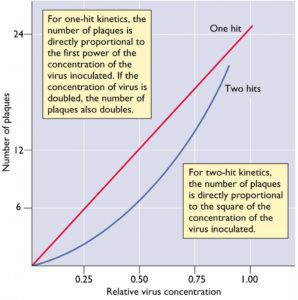

Sequence analysis of viruses isolated from Culex mosquitoes in Central and South American Countries revealed six new viruses with segmented RNA genomes, which was confirmed by gel electrophoresis of RNA extracted from virus particles.
Some of the virus isolates appear to lack the fifth RNA segment, and the results of RNA transfection experiments indicated that this RNA is not needed for viral infectivity.
RNA viruses with segmented genomes are common, but in this case, the surprise came when it was found that the dose-response curve of infection for these viruses was not linear. In other words, one virus particle was not sufficient to infect a cell (illustrated). In this case, between 3 and 4 particles were needed to establish an infection. These findings indicate that the viral RNA segments are separately packaged, and must enter a cell together to initiation infection.
These novel viruses, called Guaico Culex virus (GCXV) are distantly related to flaviviruses, a family of non-segmented, + strand RNA viruses. They are part of a clade of RNA viruses with segmented genomes called the Jingmenvirus, which includes a novel tick-borne virus isolated in China (previously discussed on this blog), and a variant isolated from a red colobus monkey in Uganda. These viruses are also likely to have genomes that are separately packaged.
An interesting question is to identify the selection that lead to the emergence of multicomponent viruses that require multiple particles to initiate an infection. Perhaps transmission of these types of viruses by insect vectors facilitates the introduction of multiple virus particles into a cell. How such viral genomes emerged and persisted remains a mystery that might be solved by the analysis of other viruses with similar genome architectures.

Pingback: Animal viruses with separately packaged RNA seg...